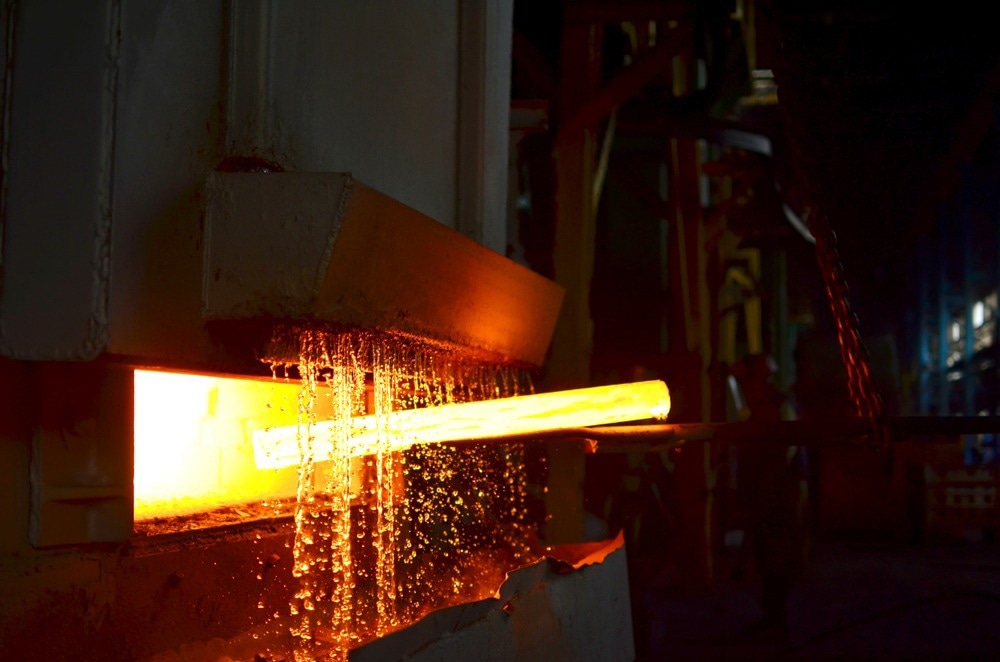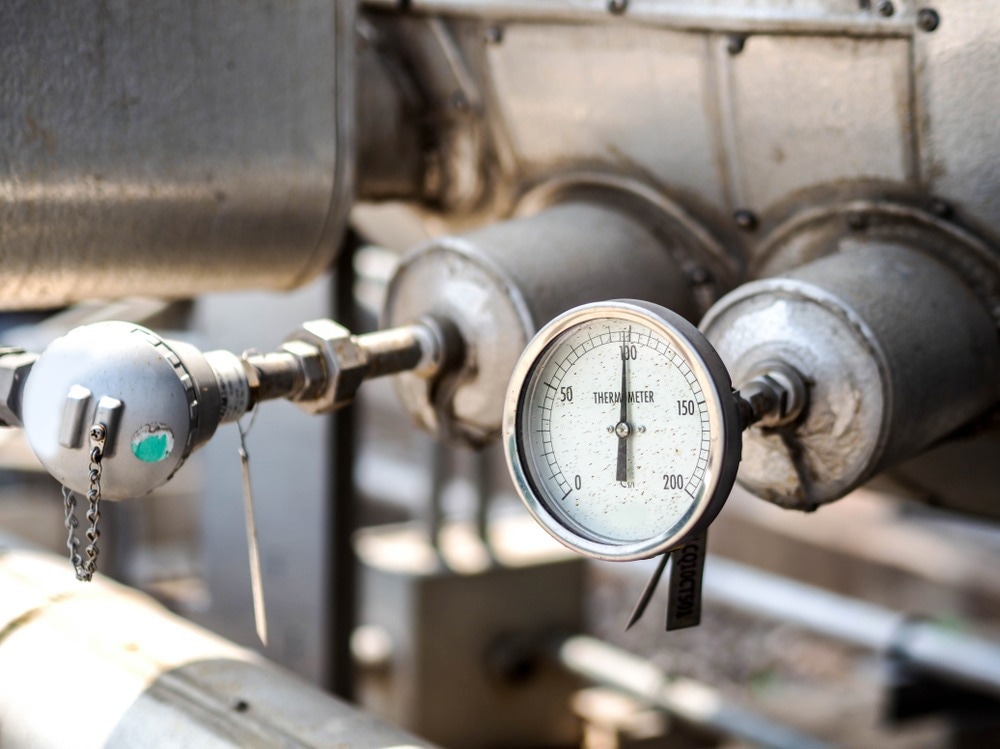Heat treatment is a common process employed in manufacturing industries to improve the quality of materials or make them suitable for different kinds of applications.

Image Credit: Maksim Safaniuk/Shutterstock.com
In this article, AZoSensors discuss heat treatment applications, why it is important to monitor temperature during manufacturing, sensors as monitoring solutions, and future directions of temperature sensors in the heat treatment process.
What is Heat Treatment?
Heat treatment is a method that is frequently used in many industrial manufacturing pipelines. The process involves altering the characteristics of materials like metals or glass through heating. It can be implemented at low and high temperatures to change the ductility, hardness, or other properties of materials with various crystal structures.
Industrial Applications of Heat Treatment
During manufacturing, metals can be softened by heat treatment to increase formability, while parts of it may be made harder to increase strength. Also, heat treatment can be utilized to create a hard surface on relatively soft components to boost abrasion resistance.
In other applications, it is used to create corrosion-resistant skin to protect components from corrosion that would otherwise occur and help strengthen fragile products. This significantly increases a product's range of applications.
The development of alloying and heat treatment, as well as the subsequent heat treatment impacts on microstructural evolution and mechanical properties of aluminum (Al) containing Fe-Mn-C-Al steel, are introduced in an article published in Steel Research International Journal. Due to their lightweight construction and exceptional mechanical qualities, these have significant applications in the mining, transportation, and aviation industries as structural materials and components.
The Importance of Monitoring Temperature During Heat Treatment
Heat treatment is not a process that occurs randomly or by trial and error. Too high of a temperature can cause unwanted phases to develop or a metallurgical change to happen too quickly. A temperature that is too low might lead to insufficient stress relief, insufficient softening of cold-treated metals, and incomplete metallurgical reactions.
To create high-quality parts and components with the desired qualities, accurate temperature and timing management are required. Another crucial process parameter is the rate of cooling after high-temperature heat treatment. If temperatures are permitted to fluctuate too much, they can interfere with the production process in addition to destroying the final product.
Lack of temperature control can also be harmful to the personnel and machines, which eventually can cause companies to incur severe losses.

Image Credit: engineer story/Shutterstock.com
Temperature Sensors and How They Can Monitor Temperature
Temperature sensors are made of two metals that produce an electrical voltage or resistance whenever there is a temperature change. These electrical signals are converted to readings that can be easily interpretable by users. The temperature change happens linearly to the change in voltage.
There are many types of sensors, and they are divided into groups according to how they connect. When it comes to temperature sensors, there are two primary categories depending on the type of application or industry. These can be either contact or non-contact temperature sensors.
For contact temperature sensors, direct contact is employed to determine how hot or cold something is. Typically, they are used to measure a wide range of temperatures in various solids, liquids, or gases.
Meanwhile, in non-contact temperature sensors, their meters are frequently employed in hazardous locations, such as the power plant sectors, because they never come into direct touch with an object or material. They use the radiation that is emitted by a heat source to gauge how hot or cold something is.
Examples of heat sensor types include thermometers, thermostats, thermistors, thermocouples, negative temperature coefficient (NTC) thermistors, semiconductor-based temperature sensors, and resistive temperature detectors (RTDs).
How Are Temperature Sensors Applied to the Heat Treatment Processes?
Temperature sensors need to be able to withstand exposure to harsh temperatures and conditions in the heat-treating sector. For this, thermoelectric temperature sensors such as thermocouples are the most used to measure temperature.
The heat treatment processes of annealing, hardening (nitriding, carburizing, sintering), forging, pickling, and extrusion require temperature sensors.
Some commercially available temperature sensors for industrial heat treatment monitoring include:
PSC Surveyor Series Thermal Imaging Cameras
They can be used to continuously monitor and manage industrial processes. The process sensors surveyor camera series provides an extensive range of image and line scanning camera systems. It can measure temperatures within the range of -20 and 1800 degrees Celsius.
PSC-40 Series
The PSC-40 Series is a two-wired, loop-powered infrared sensor with precise temperature ranges from -40 to 2500°C and either variable focus or fixed focus lenses. They are also offered fiber optics. The pyrometer's parameters can be changed using an extra programming cord and software.
Industrial applications such as induction heating, food, dryers, ovens, steel manufacturing, glass, kilns, furnaces, medical equipment, and R&D are all made possible by the wiring's simplicity and integration's ease of use.
The Metis M3 Pyrometer
The effective process sensors one-color and two-color Metis M3 Series pyrometers are offered with adjustable focus, through a lens, laser, or video sighting optics. 50°C to 3300°C is the temperature range and has a temperature display on board. There are fiber optics for use in environments with high ambient temperatures, as well as Ethernet output provided.
Some more sensors are RTD platinum thin film element and tip-sensitive bearing thermocouple.
Conclusion
Grand View Research estimates that the global market for heat treating was worth USD 100.73 billion in 2021 and is projected to increase at a CAGR of 3.4% from 2022 to 2030. Meanwhile, Markets & Markets estimates that the temperature sensor market will grow at a CAGR of 4.5% from 2021 to 2028, from USD 5.9 billion in 2021 to USD 8.0 billion by 2028.
These figures show that their heat treatment and temperature monitoring will continue to play a significant role in manufacturing for quite a long time.
References and Further Reading
Atlas Scientific. (2021) How Do Temperature Sensors Work? [Online]. Atlas Scientific. Available at: https://atlas-scientific.com/blog/how-do-temperature-sensors-work/
Grand View Research. (2020) Heat Treating Market Size & Share Report, 2022 - 2030 [Online]. Grand View Research. Available at https://www.grandviewresearch.com/industry-analysis/heat-treating-market
HTS, (2022) What is Heat Treating? - Heat Treating Society [Online]. ASM International. Accessible at: https://www.asminternational.org/web/hts/about/what-is
Hu, S., Zheng, Z., Yang, W., Yang, H. (2022) Fe–Mn–C–Al Low-Density Steel for Structural Materials: A Review of Alloying, Heat Treatment, Microstructure, and Mechanical Properties. Steel Research International 93, p. 2200191. https://doi.org/10.1002/srin.202200191
Markets and Markets (2021) Temperature Sensor Market Size, Share | Industry Report, (2021-2028) [Online]. MarketsandMarkets. Available at: https://www.marketsandmarkets.com/Market-Reports/temperature-sensor-market-522.html
Process Sensors, (2022) Temperature Measurement and Control in Metal Heat Treating Processes | Process Sensors Corp - IR Temperature Sensors [Online]. Process Sensors Corporation. Available at: https://www.processsensorsir.com/industries/metals/heat-treating-temperature
Sisson, R.D. (2001) Heat Treatment, in: Buschow, K.H.J., Cahn, R.W., Flemings, M.C., Ilschner, B., Kramer, E.J., Mahajan, S., Veyssière, P. (Eds.), Encyclopedia of Materials: Science and Technology. Elsevier, Oxford, pp. 3736–3741. https://doi.org/10.1016/B0-08-043152-6/00666-5
Disclaimer: The views expressed here are those of the author expressed in their private capacity and do not necessarily represent the views of AZoM.com Limited T/A AZoNetwork the owner and operator of this website. This disclaimer forms part of the Terms and conditions of use of this website.